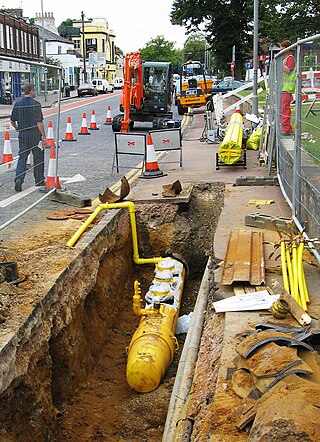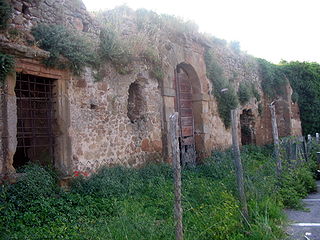
A road is a linear way for the conveyance of traffic that mostly has an improved surface for use by vehicles and pedestrians. Unlike streets, the main function of roads is transportation.

A trench is a type of excavation or depression in the ground that is generally deeper than it is wide, and narrow compared with its length.

There are three related types of Neolithic earthwork that are all sometimes loosely called henges. The essential characteristic of all three is that they feature a ring-shaped bank and ditch, with the ditch inside the bank. Because the internal ditches would have served defensive purposes poorly, henges are not considered to have been defensive constructions. The three henge types are as follows, with the figure in brackets being the approximate diameter of the central flat area:
- Henge. The word henge refers to a particular type of earthwork of the Neolithic period, typically consisting of a roughly circular or oval-shaped bank with an internal ditch surrounding a central flat area of more than 20 m (66 ft) in diameter. There is typically little if any evidence of occupation in a henge, although they may contain ritual structures such as stone circles, timber circles and coves. Henge monument is sometimes used as a synonym for henge. Henges sometimes, but by no means always, featured stone or timber circles, and circle henge is sometimes used to describe these structures. The three largest stone circles in Britain are each within a henge. Examples of henges without significant internal monuments are the three henges of Thornborough Henges. Although having given its name to the word henge, Stonehenge is atypical in that the ditch is outside the main earthwork bank.
- Hengiform monument. Like an ordinary henge, except the central flat area is between 5 and 20 m (16–66 ft) in diameter, they comprise a modest earthwork with a fairly wide outer bank. The terms Mini henge or Dorchester henge are sometimes used as synonyms for hengiform monument. An example is the Neolithic site at Wormy Hillock Henge.
- Henge enclosure. A Neolithic ring earthwork with the ditch inside the bank, with the central flat area having abundant evidence of occupation and usually being more than 300 m (980 ft) in diameter. Some true henges are as large as this, but lack evidence of domestic occupation. Super henge is sometimes used as a synonym for a henge enclosure. However, sometimes Super henge is used to indicate size alone rather than use, e.g. "Marden henge ... is the least understood of the four British 'superhenges' ".

A berm is a level space, shelf, or raised barrier separating areas in a vertical way, especially partway up a long slope. It can serve as a terrace road, track, path, a fortification line, a border/separation barrier for navigation, good drainage, industry, or other purposes.

A grader, also commonly referred to as a road grader, motor grader, or simply a blade, is a form of heavy equipment with a long blade used to create a flat surface during grading. Although the earliest models were towed behind horses, and later tractors, most modern graders are self-propelled and thus technically "motor graders".

Danebury is an Iron Age hillfort in Hampshire, England, about 19 kilometres (12 mi) north-west of Winchester. The site, covering 5 hectares, was excavated by Barry Cunliffe in the 1970s. Danebury is considered a type-site for hill forts, and was important in developing the understanding of hillforts, as very few others have been so intensively excavated.

Cyclo-cross is a form of bicycle racing. Races typically take place in the autumn and winter, and consist of many laps of a short course featuring pavement, wooded trails, grass, steep hills and obstacles requiring the rider to quickly dismount, carry the bike while navigating the obstruction and remount. Races for senior categories are generally between 40 minutes and an hour long, with the distance varying depending on the ground conditions. The sport is strongest in the traditional road cycling countries such as Belgium, France and the Netherlands.

Oval track racing is a form of closed-circuit motorsport that is contested on an oval-shaped race track. An oval track differs from a road course in that the layout resembles an oval with turns in only one direction, and the direction of traffic is almost universally counter-clockwise. Oval tracks are dedicated motorsport circuits, used predominantly in the United States. They often have banked turns and some, despite the name, are not precisely oval, and the shape of the track can vary.

A dirt road or track is a type of unpaved road not paved with asphalt, concrete, brick, or stone; made from the native material of the land surface through which it passes, known to highway engineers as subgrade material. Dirt roads are suitable for vehicles; a narrower path for pedestrians, animals, and possibly small vehicles would be called a dirt track—the distinction is not well-defined. Unpaved roads with a harder surface made by the addition of material such as gravel and aggregate (stones), might be referred to as dirt roads in common usage but are distinguished as improved roads by highway engineers.

A gravel road is a type of unpaved road surfaced with gravel that has been brought to the site from a quarry or stream bed. They are common in less-developed nations, and also in the rural areas of developed nations such as Canada and the United States. In New Zealand, and other Commonwealth countries, they may be known as metal roads. They may be referred to as "dirt roads" in common speech, but that term is used more for unimproved roads with no surface material added. If well constructed and maintained, a gravel road is an all-weather road.

An agger (Latin) is an ancient Roman linear mound or embankment. The word is sometimes applied to fortifications, such as the Agger Servianus, a part of the Servian Wall of Rome, which protected the city on its most vulnerable side, the Campus Esquilinus. It consisted of a double rampart bearing formidable fortifications. In modern usage however, particularly in British archaeology, it is most commonly used to describe the ridge or embankment on which Roman roads were built. The course of a Roman road can often be traced today by the distinctive line of the agger across the landscapeand even when destroyed by agriculture, the vestigial mound that can persist has allowed archaeologists in recent years to trace the course of many Roman roads using lidar.

The Umbilicus Urbis Romae —"Navel of the City of Rome"—was the symbolic centre of the city from which, and to which, all distances in Ancient Rome were measured. It was situated in the Roman Forum where its remnants can still be seen. These remains are located beside the Arch of Septimius Severus and the Vulcanal, behind the Rostra. Originally covered in marble, the Umbilicus is now a forlorn-looking brick core some 2 metres high and 4.45 metres in diameter.

A street gutter is a depression that runs parallel to a road and is designed to collect rainwater that flows along the street diverting it into a storm drain. A gutter alleviates water buildup on a street, allows pedestrians to pass without walking through puddles, and reduces the risk of hydroplaning by road vehicles. When a curbstone is present, a gutter may be formed by the convergence of the road surface and the vertical face of the sidewalk; otherwise, a dedicated gutter surface made of concrete may be present. Depending on local regulations, a gutter usually discharges, as a nonpoint pollution source in a storm drain whose final discharge falls into a detention pond or into a body of water. Street gutters are most often found in areas of a city which have high pedestrian traffic. In rural areas, gutters are seldom used and are frequently replaced by a borrow ditch.

Killarney Motor Racing Complex, whose main race track is also known as Killarney International Raceway, is a motor racing complex in Milnerton Rural, Cape Town, South Africa. It first saw action in 1947.
A flat bar road bike, also called a fitness bike, is a hybrid bike optimized for road usage or a road bike with a flat handlebar in place of a drop bar.

The Trundle is an Iron Age hillfort on St Roche's Hill about 4 miles (6 km) north of Chichester, West Sussex, England, built on the site of a causewayed enclosure, a form of early Neolithic earthwork found in northwestern Europe. Causewayed enclosures were built in England from shortly before 3700 BC until at least 3500 BC; they are characterized by the full or partial enclosure of an area with ditches that are interrupted by gaps, or causeways. Their purpose is not known; they may have been settlements, meeting places, or ritual sites. Hillforts were built as early as 1000 BC, in the Late Bronze Age, and continued to be built through the Iron Age until shortly before the Roman occupation.
The following is a glossary of terminology used in motorsport, along with explanations of their meanings.
Fort Center is an archaeological site in Glades County, Florida, United States, a few miles northwest of Lake Okeechobee. It was occupied for more than 2,000 years, from 450 BCE until about 1700 CE. The inhabitants of Fort Center may have been cultivating maize centuries before it appeared anywhere else in Florida.
In geotechnical engineering, an interceptor ditch is a small ditch or channel constructed to intercept and drain water to an area where it can be safely discharged. These are used for excavation purposes of limited depth made in a coarse-grained soils. These are constructed around an area to be dewatered. Sump pits are also placed at suitable intervals for installation of centrifugal pumps to remove the water collected in an efficient manner. In fine sands and silts, there may be sloughing, erosion or quick conditions. For such type of soils the method is confined to a depth of 1 to 2 m. Interceptor ditches are most economical for carrying away water which emerge on the slopes and near the bottom of the foundation pit. Its size depends on the original ground slope, runoff area, type of soil and vegetation, and other factors related to runoff volume.

Digging, also referred to as excavation, is the process of using some implement such as claws, hands, manual tools or heavy equipment, to remove material from a solid surface, usually soil, sand or rock on the surface of Earth. Digging is actually the combination of two processes, the first being the breaking or cutting of the surface, and the second being the removal and relocation of the material found there. In a simple digging situation, this may be accomplished in a single motion, with the digging implement being used to break the surface and immediately fling the material away from the hole or other structure being dug.















